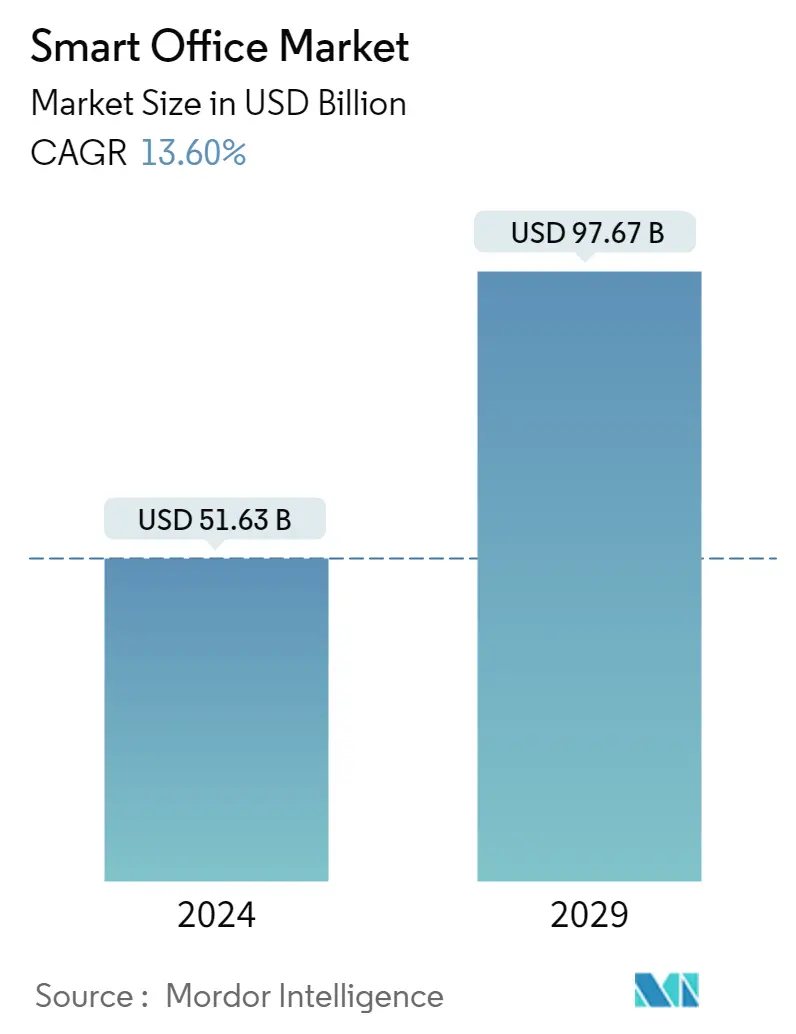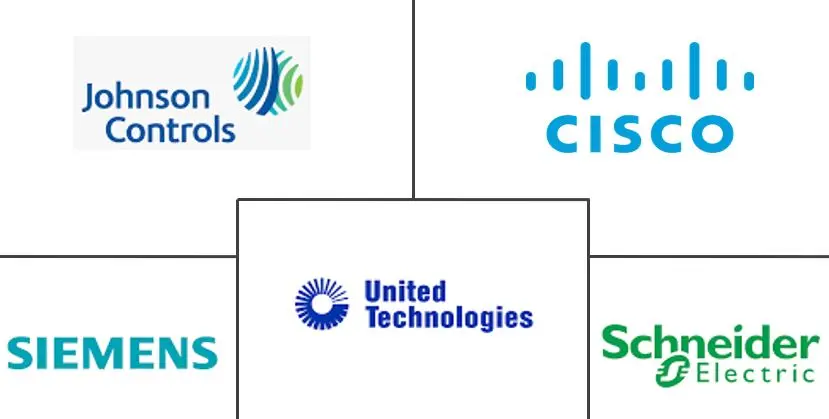Market Size of Smart Office Industry

| Study Period | 2019 - 2029 |
| Market Size (2024) | USD 51.63 Billion |
| Market Size (2029) | USD 97.67 Billion |
| CAGR (2024 - 2029) | 13.60 % |
| Fastest Growing Market | Asia Pacific |
| Largest Market | Europe |
| Market Concentration | Low |
Major Players
*Disclaimer: Major Players sorted in no particular order |
Smart Office Market Analysis
The Smart Office Market size is estimated at USD 51.63 billion in 2024, and is expected to reach USD 97.67 billion by 2029, growing at a CAGR of 13.60% during the forecast period (2024-2029).
The market is primarily driven by factors such as the rise in demand for intelligent office solutions, sensor networks for energy efficiency, favorable government regulations, advancement of IoT in innovative office offerings, and the growing need for safety and security systems at the workplace.
- The concept of smart cities marked a great prospect with the Internet of Things in the energy, waste, and infrastructure sectors. A smart home, a significant part of a smart city, offers several benefits. Several ongoing smart city projects and initiatives are expected to be completed by 2025. It is expected that there will be about 30 global smart cities, and 50% of these are expected to be located in North America and Europe.
- According to the OECD, these steps are supported by global investments, which are expected to be about USD 1.8 trillion from 2010-2030 (for all infrastructure projects in urban cities). The investment in digitized infrastructure is expected to drive the demand for securing those assets.
- Additionally, the construction of more modern infrastructure at business locations, which offers greater luxury, is influenced by the rising worldwide internet penetration, thus boosting the market growth. For instance, data reportal shows more than five billion people used the internet as of April 2022, making up 63.1% of the world's population.
- The COVID-19 outbreak has enabled companies to provide advanced and technologically updated facilities at the workplace. As companies increasingly shift to a smart hybrid working model, the demand for a smart workplace is witnessing growth. These companies are focusing on the seamless integration of work through physical and virtual space, people, and technology which thereby yields better and faster output.
- Monitoring indoor air quality is one key concern emerging from the pandemic. AI-driven occupancy sensors and beacons gather data about the number of people in the workplace, as well as how different spaces are being used at different times. As these are linked to the main system, the underlying technology ensures workspaces and energy are used efficiently, lowering CO2 levels and decreasing emissions simultaneously. With smart air purifiers, companies are minimizing the risk of airborne viruses while making workers feel safer and meeting their sustainability goals simultaneously.
Smart Office Industry Segmentation
The smart office systems deploy automated systems, sensors, and advanced communication infrastructure and networks, which provide centralized control and wireless data transfer for monitoring and analysis.
The Smart Office Market is segmented by Product, including Security and Access Control systems, Energy Management Systems, Smart HVAC Control Systems, Audio-video Conferencing Systems, and Fire and Safety Control Systems, among others. Moreover, the report also considers Building Types such as Retrofits New Buildings and Geography. The market sizes and forecasts are provided in terms of value (USD million) for all the above segments.
| Product | |
| Security and Access Control System | |
| Energy Management System | |
| Smart HVAC Control System | |
| Audio-Video Conferencing System | |
| Fire and Safety Control System | |
| Other Products |
| Building Type | |
| Retrofits | |
| New Buildings |
| Geography | |||||||
| |||||||
| |||||||
| |||||||
| |||||||
|
Smart Office Market Size Summary
The smart office market is poised for significant growth, driven by the increasing demand for intelligent office solutions and advancements in IoT technology. The market is experiencing a surge in interest due to the integration of sensor networks aimed at enhancing energy efficiency and the growing emphasis on safety and security systems in the workplace. The shift towards smart hybrid working models, accelerated by the COVID-19 pandemic, has further fueled the demand for smart workplaces. Companies are focusing on the seamless integration of physical and virtual spaces, which is enhancing productivity and efficiency. The adoption of energy management systems is also on the rise, as organizations seek to optimize energy consumption and reduce costs, aligning with global sustainability goals.
North America leads the global smart office market, benefiting from advanced technological infrastructure and favorable government regulations. The region's early adoption of IoT technologies in various industries, including intelligent offices, is driving market expansion. The increasing penetration of IoT consumer devices, particularly smartphones, is further supporting the growth of smart workplaces in the United States. The competitive landscape of the smart office market is characterized by the presence of major players such as Johnson Controls International PLC, Cisco Systems Inc., and Siemens AG, who are leveraging strategic collaborations and innovations to enhance their market share. These companies are continuously introducing advanced solutions to meet the evolving demands of modern workplaces, thereby contributing to the market's robust growth trajectory.
Smart Office Market Size - Table of Contents
-
1. MARKET DYNAMICS
-
1.1 Market Drivers
-
1.1.1 Increasing Focus on Energy Efficiency in Office Spaces
-
1.1.2 Rapidly Developing Business Infrastructure
-
-
1.2 Market Restraints
-
1.2.1 Security Concerns Related to IoT and Smart Devices
-
1.2.2 Higher Costs of Refurbishment of Old Buildings
-
-
1.3 Assessment of the Impact of COVID-19 on the Industry
-
-
2. MARKET SEGMENTATION
-
2.1 Product
-
2.1.1 Security and Access Control System
-
2.1.2 Energy Management System
-
2.1.3 Smart HVAC Control System
-
2.1.4 Audio-Video Conferencing System
-
2.1.5 Fire and Safety Control System
-
2.1.6 Other Products
-
-
2.2 Building Type
-
2.2.1 Retrofits
-
2.2.2 New Buildings
-
-
2.3 Geography
-
2.3.1 North America
-
2.3.1.1 United States
-
2.3.1.2 Canada
-
-
2.3.2 Europe
-
2.3.2.1 Germany
-
2.3.2.2 United Kingdom
-
2.3.2.3 France
-
2.3.2.4 Spain
-
2.3.2.5 Rest of Europe
-
-
2.3.3 Asia-Pacific
-
2.3.3.1 China
-
2.3.3.2 India
-
2.3.3.3 Australia
-
2.3.3.4 Rest of Asia-Pacific
-
-
2.3.4 Latin America
-
2.3.4.1 Brazil
-
2.3.4.2 Mexico
-
2.3.4.3 Rest of Latin America
-
-
2.3.5 Middle East and Africa
-
2.3.5.1 Saudi Arabia
-
2.3.5.2 United Arab Emirates
-
2.3.5.3 South Africa
-
2.3.5.4 Rest of Middle East and Africa
-
-
-
Smart Office Market Size FAQs
How big is the Smart Office Market?
The Smart Office Market size is expected to reach USD 51.63 billion in 2024 and grow at a CAGR of 13.60% to reach USD 97.67 billion by 2029.
What is the current Smart Office Market size?
In 2024, the Smart Office Market size is expected to reach USD 51.63 billion.

